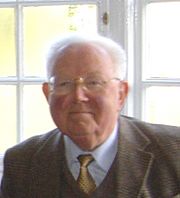Sam Edwards (physicist) facts for kids
Quick facts for kids
Sam Edwards
FRS FLSW
|
|
|---|---|
 |
|
| Born | 1 February 1928 Swansea, Wales
|
| Died | 7 May 2015 (aged 87) Cambridge, England
|
| Nationality | Welsh |
| Alma mater | University of Cambridge Harvard University |
| Known for | path integral formulation polymer physics spin glass granular material |
| Awards | Maxwell Medal and Prize (1974) Davy Medal (1984) Boltzmann medal (1995) Royal Medal (2001) Dirac Medal (2005) |
| Scientific career | |
| Fields | Physics |
| Institutions | University of Cambridge |
| Thesis | A new approach to the theory of renormalised fields (1954) |
| Doctoral advisor | Julian Schwinger |
| Doctoral students | Elliott H. Lieb Monica Olvera de la Cruz Michael Cates Nigel Goldenfeld Tanniemola Liverpool |
Sir Samuel Frederick Edwards (born February 1, 1928 – died May 7, 2015) was a famous Welsh physicist. He was known for his important work in understanding how materials like plastics and gels behave.
A special award, the Sam Edwards Medal and Prize, is named after him to honor his contributions to science.
Contents
Early Life and Education
Sam Edwards was born in Swansea, Wales, on February 1, 1928. His parents were Richard and Mary Jane Edwards.
He went to school at Bishop Gore School in Swansea. Later, he studied at several universities, including Gonville and Caius College, Cambridge, the University of Manchester, and Harvard University in the United States.
At Harvard, he worked on his PhD thesis with a famous scientist named Julian Schwinger. His research focused on the structure of electrons.
Amazing Discoveries in Physics
Edwards started his work in a field called condensed matter physics in 1958. This area of physics looks at the properties of materials like liquids, solids, and gels.
He showed that you could use special math methods, usually used for tiny particles, to understand messy materials. These materials include things like glass and gel.
For over 35 years, Edwards studied complex materials such as polymers (like plastics), gels, and colloids (mixtures like milk or paint).
Understanding Polymers
In 1965, Edwards published a very important paper. It helped scientists truly understand how polymers behave. Polymers are long chains of molecules.
Another famous scientist, Pierre-Gilles de Gennes, built on Edwards's ideas. This work eventually led to de Gennes winning the Nobel Prize in Physics in 1991.
The Replica Trick
Edwards also invented a clever math trick called the "replica method." He used it to study "glassy systems." These are materials that are disordered, like glass, but not quite solid or liquid.
His important paper from 1971 introduced this method. It helped explain things like spin glasses and amorphous solids (solids without a clear shape).
This groundbreaking work by Edwards also led to Giorgio Parisi winning the Nobel Prize in Physics in 2021.
How Polymers Flow
Edwards also contributed to the "Doi-Edwards theory." This theory explains how melted polymers flow and change shape.
His first ideas on this came out in 1967. Later, he worked with Masao Doi to fully develop this important theory in the late 1970s.
Awards and Recognition
Sam Edwards was a very respected scientist. He was made a knight in 1975, which means he could be called "Sir Sam Edwards."
He received many important awards for his work, including:
- The Davy Medal in 1984.
- The Royal Medal in 2001. Both of these are from the Royal Society.
- The Boltzmann medal in 1995.
- The Dirac Medal in 2005.
He was also a founding member of the Learned Society of Wales. From 1984 to 1995, he was the Cavendish Professor of Physics at Cambridge University, a very important position.
Personal Life
In 1953, Sam Edwards married Merriell E.M. Bland. They had three daughters and one son.
Outside of his scientific work, he enjoyed gardening and listening to chamber music.
Sir Sam Edwards passed away in Cambridge, England, on May 7, 2015.


